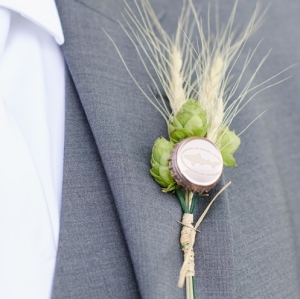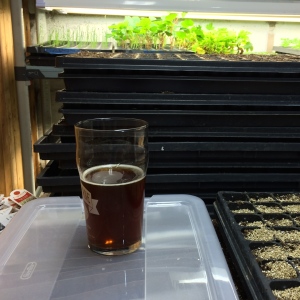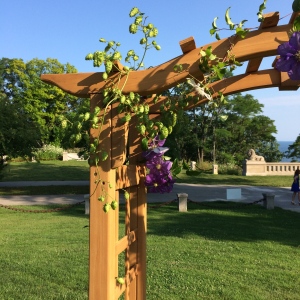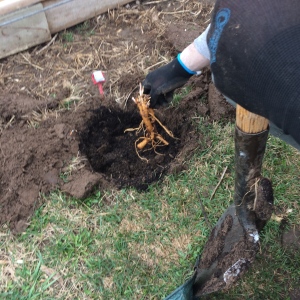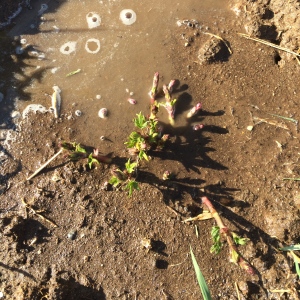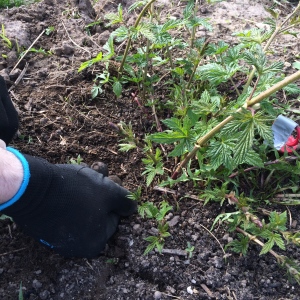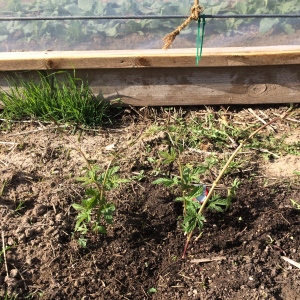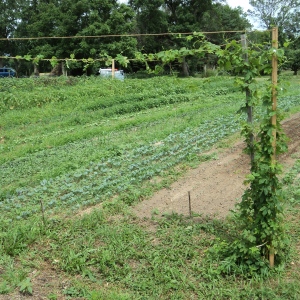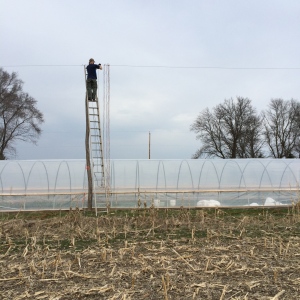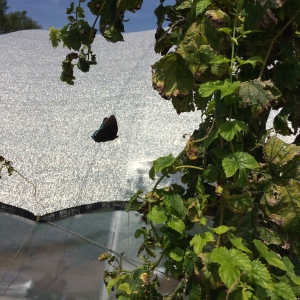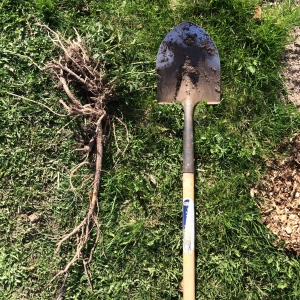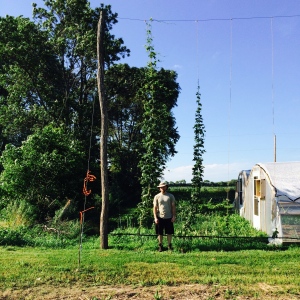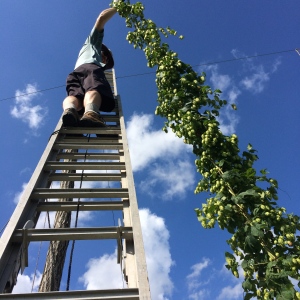Yes we grow hops on our flower farm. We love them. They are a beautiful addition to floral designs and Nich likes to brew beer, so we fight over them every year. Our answer to this dilemma was to plant more hops! It all started about 5 years ago with a couple of rhizomes from a friend who thought we should grow some. So we did. The next year we planted a few more, and then a few more, and then…. We now have 22 different plants, all different varieties, growing in a line next to the hoophouse. Here are some of the lovely outcomes of our hops production:
- beer themed boutonniere…or beertonniere?
- delicious home brew
- hops and clematis on an arbor for a wedding
Plant the rhizomes in the spring (like now) and we always spring for the jumbo roots. We have gotten some from a local home brew shop, Freshops.com, Great Lakes Hops, and an organic producer Thyme Garden. They all have great info on their websites but one of the best websites for when and how much individual varieties produce is Beer Legends. Another fantastic resource for us has been Gorst Valley Hops. They offer intense workshops and have done lots of research on growing/producing and what not. Rumor has it that they are going to be selling plants that are certified disease free, which is great because nobody else does that and we did get in a disease last year from a previously reputable source. Sounds like this is becoming more common with the growing popularity and demand for plants. The vines are actually bines, but I am going to call them vines because I always think bines looks like a typo. They are aggressive plants and need to be thinned and pruned during the season to keep them in check. We select about 4 of the nicer looking sprouts to keep every spring and then pinch out the other sprouts, you have to do this every week because they keep on coming. It slows down in July.
- planting new rhizomes mid April, ammended with compost
- sprouts mid April from old plants, need lots of water
- pinching out the sprouts: keep it to about 4 good vines and the rest need to be removed.
- sprouts have been selected and the losers have been removed, top dressed with compost
They are heavy feeders and drinkers, if you want pretty green cones you better make sure they get plenty of water. We have an irrigation line on them and feed with a granular three times per year as well as a good dose of compost in the spring. They grow about 20 feet high by their second year, you can grow them horizontally but they may require a bit of help. We set up this weenie trellis the first year which broke and then we tried a couple of other things in the next year but it was apparent that we needed serious support. And if you want to grow 20 plants you would need a lot of room to go horizontal. Black locust is the tree of choice for this because it is abundant in these parts, it is very rot resistant, and it grows tall and straight. So we went into the woods with Gramps, his tractor, and a couple of chainsaws and we came out with three 25 foot long posts. They went about 4 feet into the ground and were set in cement. Wire cables are attached to the top of each post and run down to ground anchors to keep the whole thing from toppling over. Those plants get tall and bushy and on a breezy day… well, the guy lines are a good idea. Wire cable also runs along the top and bottom with coir rope attached for each plant to grow up. Yes that is a twenty foot extension ladder and yes it makes me nervous. You have to go up every spring to tie the ropes and every fall to cut the plants down.
- the first year trellis some 2×2’s and garden twine, it broke, couldn’t handle the weight.
- Attaching coir ropes for the vines to grow up
- wind damage on leaves, not enough water probably also contributed
- three year old plant we removed. There were about four roots this size that came out
- first year plants with second and third year plants
- late June four year old cascade
- late July four year old cascade
- harvest day around the beginning of September
You won’t harvest much the first and second year. There will be some cones that you can pick but leave the leaves and vine in place. Much like peonies you need that plant to feed the root system so that you get nice plants in the future. By the third or fourth year you should have vigorous plants and it is then OK to cut the entire plant when you harvest.
I like to harvest when they are pretty and green, which is too early if you want them for beer brewing. It’s about a 2-3 week window before they begin to lose their vibrancy and get a little papery, which is still pretty… but not as pretty. With all of our varieties I can have hops for design use from about mid-July through September, maybe early October. So what are some of my favorite varieties? I will have to update this at the end of the season after some of these plants come into their third year but for now they are:
- Cascade: this one is easy to find, you can probably pick one up at your local garden center. It is vigorous and produces tons of cones on appropriately sized side branches.
- Nugget: produces big beautiful cones. I know some people like Chinook for this but I prefer the shape of Nugget.
- Saaz: it is a European variety which I have heard complaints about it not growing very well here. I think it produces lovely cones and produces early. It is not as vigorous as others but it work for me.
A few issues/lessons learned:
- They are prone to some viruses and downy mildews. Allegedly most of these should not be a problem for your flower crops but I don’t trust that. We thought we had some hops downy mildew and sent in a sample, turned out to be wind damage and probably also not enough water. Whew! What a relief. The leaves were not attractive and had to be removed but most of the cones were fine. We also though we had a virus on one…. and we were correct. The plant had to be destroyed and removed.
- Japanese beetles can be a problem but we are already used to that. Not much you can do but pick off the unattractive parts
- Spider mites, we got them bad one year. It was the year of the horrible drought which was also the year that soybeans were planted in the adjacent field. Most hops were not usable but we have not had that problem since.
- They are heavy feeders! We planted these about 2 feet from the edge of my hoophouse. There were dahlias in there planted about 5-6 feet away from the hops. They did not perform well and some looked a bit chlorotic by August.
- Use new rope every year. Even if you are able to get the hops off the rope intact that rope will not be able to support those heavy plants next year. It will come down with a strong wind three weeks before they are ready for harvest on a day when you really don’t have time to deal with it… hypothetically speaking of course.
Here is a link for an IPM guide, it’s a big one but if you really want to know something about IPM on hops this is the place to look.
